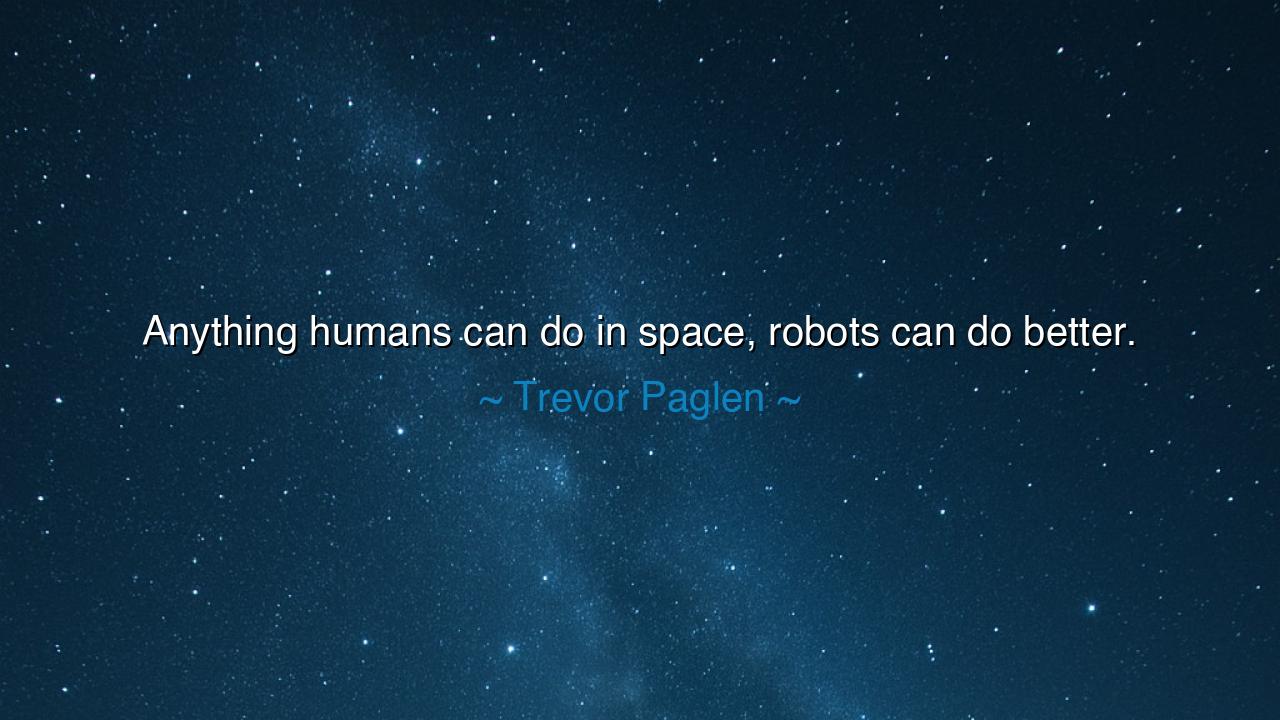
Anything humans can do in space, robots can do better.






Hear the words of Trevor Paglen, artist of the unseen and chronicler of the skies: “Anything humans can do in space, robots can do better.” At first, these words seem cold, a triumph of machine over flesh. Yet within them lies a profound meditation on the limits of the human body, the dangers of the void beyond Earth, and the relentless ingenuity that compels us to send forth not only ourselves, but also our creations, into the stars.
The meaning is this: the realm of space is vast, hostile, and unforgiving. Humans, fragile and bound by the needs of air, food, water, and warmth, are poorly suited to its cold emptiness. Yet the robot, untroubled by hunger or fear, moves with tireless endurance. It can endure radiation, survive without sleep, and traverse landscapes that would kill a mortal in an instant. Thus, Paglen reminds us that in the contest of survival among the stars, the machine surpasses the maker.
The origin of this insight lies in the history of exploration itself. Since the dawn of the space age, nations have sent machines first, before daring to send flesh and blood. The Soviet Luna probes, the American Voyagers, the Martian rovers such as Spirit, Opportunity, and Perseverance—all of these have done what no human hand could: wander deserts of alien dust, gaze upon unknown horizons, and send their visions back across the gulf of space. They have proven that robots are not only our tools, but our emissaries to worlds beyond reach.
History gives us vivid examples. Recall the tragedy of the Challenger disaster, when human lives were lost in the pursuit of the heavens. Or the peril of Apollo 13, when astronauts hovered on the edge of death in the silence of space. In these moments, the fragility of the human form was laid bare. Yet the machines we built—those quiet, unsleeping messengers—have never wavered. The Voyager probes still drift, carrying whispers of Earth beyond the edge of the solar system, outlasting the hands that made them. Truly, there is wisdom in Paglen’s observation.
And yet, there is another side to this truth. For though robots can do better, they cannot dream. They cannot feel awe beneath alien suns, nor write poetry of the silence of Mars. They cannot taste fear, or courage, or wonder. Thus, while the machine may excel in labor, the human spirit remains the soul of exploration. Paglen’s words are a reminder not of our irrelevance, but of our need for humility: we are not masters of the stars, but fragile voyagers who must walk alongside our creations if we wish to endure.
The lesson for us, children of Earth, is clear: let us not see machines as rivals, but as extensions of ourselves. Use them where our bodies fail; honor them as tools that magnify human reach. But do not forget that the meaning of exploration lies not in efficiency, but in the act of reaching, seeing, and feeling. A robot may touch the surface of another world, but only a human can give that touch meaning, by carrying within themselves the memory, the culture, the yearning of all humanity.
Practical action flows from this truth. Embrace the aid of machines in your labors; do not resist the tools that can surpass your strength or endurance. Yet never surrender the spark of the human soul—curiosity, empathy, imagination—that no machine can replicate. Whether in the pursuit of science, of art, or of justice, remember that your creations may do better, but only you can make them meaningful.
Take this as a guiding flame: “Anything humans can do in space, robots can do better.” It is both warning and wisdom. Trust the machine to extend your reach, but trust yourself to give that reach purpose. For the stars may one day belong to robots, but the story of why we reached for them will always be written by humans.






AAdministratorAdministrator
Welcome, honored guests. Please leave a comment, we will respond soon